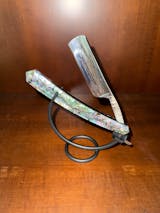Nearly 200 million people in the United States use disposable razors and safety razor blades, which take 1,000 years to decompose and contribute significantly to the rapidly accumulating waste in landfills. It’s important to highlight a simple fact—recycling razor blades helps shave the planet if you don't mind the pun. Don't just toss your razors in the garbage after shaving! Learning how to recycle razor blades is an important step toward reducing the harmful ecological and environmental impacts of shaving.
According to experts at the Natural Resources Defense Council for Food and Agriculture, the blades of disposable razors are not biodegradable. They also note that the blades from cartridge razors and safety razors will rust away over decades or centuries, leaving behind just the plastic handle and housing.
Yes, You Can Recycle Razor Blades
In this modern era, we are spoiled with consumer products that make our lives extra convenient. We got many single-use items, like razors, that only last up to five shaves at most.
Despite being explicitly unsustainable, plastic razors have become essential in every home. You use it for trimming beards and shaving legs—basically to remove hair in your body. However, its versatility does not justify how much it harms the environment when there are greener and better alternatives to disposable razors.
You can recycle non-medical razor blades by separating them from the plastic part of the cartridge razor and keeping them clean, packed, or disposed of in sealed containers or blade banks as needed. Local recycling centers can recover large amounts of steel and nonmedical blades as scrap metal, which must be compiled into a metal can or another container with a lid.
You can also take advantage of razor blade recycling programs that several private institutions offer. The problem is that the recycling process of these services can be complicated, and blades cannot be simply thrown into the recycling bin. There are only a few drop-off locations for blade recycling, and shipping your used razors to the facility's headquarters can be costly.
Some local pharmacies, clinics, and hospitals also let you know where to dispose of your used razor blades. A simple inquiry is all you need.

How Can I Safely Recycle Razor Blades?
The Environmental Protection Agency reported that 2 billion disposable razors were thrown away annually in the 1990s, which has only increased since then. This data merely demonstrates that disposable razors are a significant contributor to pollution.
Many of these metal materials and plastics could have been recovered and recycled instead of causing significant environmental damage. Tossing a razor in the trash isn't necessary, as much safer and longer-lasting options are available that have a less environmental impact.
Here are a few options for safely disposing of razor blades for recycling:
Sharps Containers
Unlike needles, storing razor blades in a sharpening container is a safer way to dispose of them. This container has a metal exterior and plastic construction to keep everyone safe during recycling procedures.
According to Rockwell Razors, many pharmacies and drugstores offer these containers for free. You can simply assemble and dispose of it in a municipally managed landfill and a nearby secure storage facility. Note that poor-quality blades that are not recyclable may be rejected.
Buy Or Build A Razor Blade Bank
The best way to store a razor blade is to use a blade bank—it’s like a mini recycling bin for recycling razor blades. A blade bank is a steel box designated as safe storage. You can make your own blade bank using any upcycled steel container with a lid or through a DIY project by following the under 50-cent blade bank hack from the Badger & Blade forum.
Simply remove the label from a can of broth (ideally, one you intend to use for cooking), and use a heated knife to poke a horizontal hole in the top of the can.
Once your razor's blade is dull, drop it inside your blade bank. Once you stock your box of razor blades, you can now take it to a recycling center. Make sure that it's safe and sealed with duct tape.
TerraCycle Blade Recycling Initiative
Together with industry heavyweights like Venus and Gillette, TerraCycle has launched a recycling initiative. Among the many items they transport are razors, disposable razor blades, and high-end double-bladed razors from other brands.
You can collect your blade banks, put them in a box, print a shipping label or tracking label, then drop them at any of their public drop-off points or a local recycling center.
Programs to collect potentially hazardous waste, such as razors, are available in several U.S. cities. Depending on where you live, there are a variety of places that accept unwanted or unusable items for recycling.

Alternative Ways To Repurpose Used Razor Blades
Let us show you how to use old razor blades. You know how difficult washing dishes can be. To avoid the problem, make a dish scraper using used blades. Use pliers and three razor sticks to make a tripod-like stand. Glue three blades together, and that's it! The edges of the razor are sharp enough to remove burned leftovers from your dish but not sharp enough to damage the surface.
Sharpen Blades Periodically
Safety razors are far superior than cartridge razors. If you use a safety razor, you can add an extra 7 or 8 close, comfortable shaves to your double-edge razor blade simply by sharpening it on a strop or a leather hone.
Here's how to sharpen disposable razor blades:
- Make sure that both the blade and the leather are completely dry.
- Place the safety razor at the base of the honing pad. Raise the blade until it touches the leather at an angle of about 35 degrees.
- Raise the razor to the top of the honing pad, lower it, and put it back at the bottom without dragging it back over the leather.
- Do these four or five times until they are as sharp as you want.
- After sharpening one edge, spin the razor 180 degrees and sharpen the other edge.
Cost Of Shaving And Eco-Friendly Razors

How often should you change your safety razor blade? Men who change their razors every two weeks spend $88 per month or nearly $1,000 per year. It's ridiculous to spend this much money on razors alone.
If you go a month or two without shaving, you can save up for a more environmentally friendly alternative to disposable razors, such as a straight razor, shavette, or safety razor. With a shavette razor or a safety razor, you only need to replace the blades when the old one becomes dull.
Buying traditional razors is both convenient and cost-effective. For example, a straight razor can eliminate additional shaving costs by replacing $1,000 in disposable razors. The blades last longer and are more resistant to microscopic damage.
One of the scientists leading the research into how hair dulls razor blades, Gianluca Roscioli, stated that "the size of the chips is about 1/10 of the diameter of a human hair" and that the more one shaves, the more chips appear.
Pick blades and razors made of steel that are more resistant to corrosion, wear, and tear. If you use a straight razor, you should strop it before each use to smooth out any chips in the edge. Meanwhile, honing should be performed once every three to six months or whenever there is significant damage to the blade.
Aside from steel razors, you can also opt for electric razors. Beards can be trimmed with ease, and shaves can be done in a short amount of time. Unfortunately, if you're aiming for a baby-butt smooth finish, it doesn't allow you to shave close enough to the skin.
An Urgent Need For Greener Grooming
Using better alternatives for the environment is also better for your skin. You can get a closer, more accurate shave. The single-blade construction allows you to cut hair with fewer strokes and less likelihood of irritation by positioning the blade at skin level. You won't have to deal with common issues like razor burns, ingrown hairs, or cuts.
By switching up your shaving equipment and opting for a longer-lasting option, you reduce the demand for the production of disposable razors. Long-lasting, single-blade razors have fewer parts and require less plastic packaging.
At the most recent United Nations climate summit, countries reaffirmed the goal of the Paris Agreement, which is to limit the average global temperature rise to safe levels if possible.
They even went so far as to express "alarm and utmost concern" that human activities have caused an increase in global temperatures, with impacts already being felt in every region.
Now that we are in a crucial decade for nature, even the smallest action on your part can make a big difference. You can reduce your carbon footprint and the demand for raw materials by switching to a more eco-friendly shaving routine and avoiding single-use razors.















